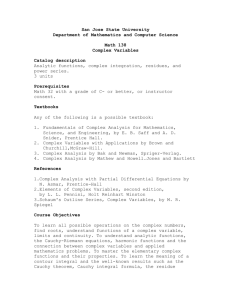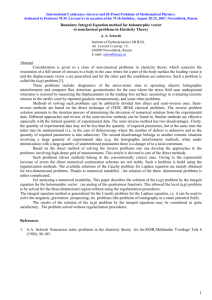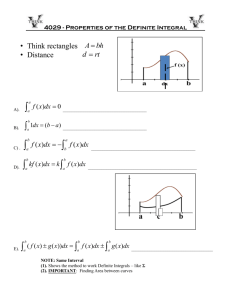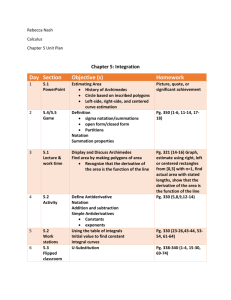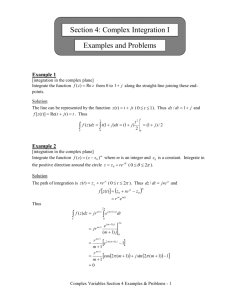BE-401 Mathematics III_1
advertisement
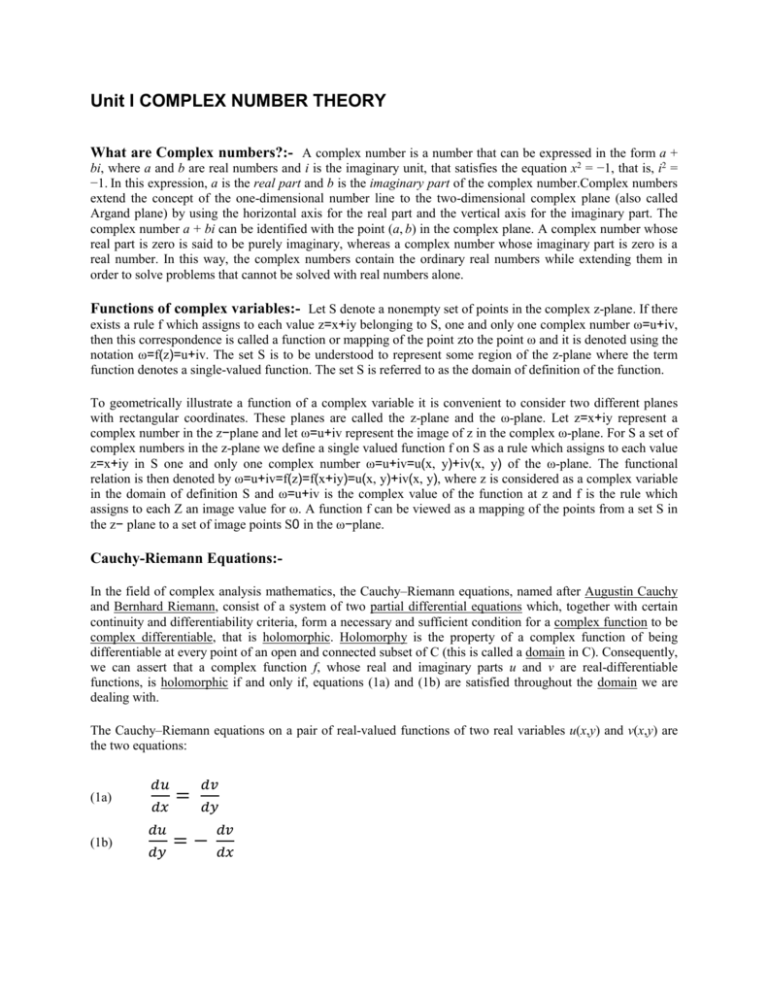
Unit I COMPLEX NUMBER THEORY
What are Complex numbers?:- A complex number is a number that can be expressed in the form a +
bi, where a and b are real numbers and i is the imaginary unit, that satisfies the equation x2 = −1, that is, i2 =
−1. In this expression, a is the real part and b is the imaginary part of the complex number.Complex numbers
extend the concept of the one-dimensional number line to the two-dimensional complex plane (also called
Argand plane) by using the horizontal axis for the real part and the vertical axis for the imaginary part. The
complex number a + bi can be identified with the point (a, b) in the complex plane. A complex number whose
real part is zero is said to be purely imaginary, whereas a complex number whose imaginary part is zero is a
real number. In this way, the complex numbers contain the ordinary real numbers while extending them in
order to solve problems that cannot be solved with real numbers alone.
Functions of complex variables:- Let S denote a nonempty set of points in the complex z-plane. If there
exists a rule f which assigns to each value z=x+iy belonging to S, one and only one complex number ω=u+iv,
then this correspondence is called a function or mapping of the point zto the point ω and it is denoted using the
notation ω=f(z)=u+iv. The set S is to be understood to represent some region of the z-plane where the term
function denotes a single-valued function. The set S is referred to as the domain of definition of the function.
To geometrically illustrate a function of a complex variable it is convenient to consider two different planes
with rectangular coordinates. These planes are called the z-plane and the ω-plane. Let z=x+iy represent a
complex number in the z−plane and let ω=u+iv represent the image of z in the complex ω-plane. For S a set of
complex numbers in the z-plane we define a single valued function f on S as a rule which assigns to each value
z=x+iy in S one and only one complex number ω=u+iv=u(x, y)+iv(x, y) of the ω-plane. The functional
relation is then denoted by ω=u+iv=f(z)=f(x+iy)=u(x, y)+iv(x, y), where z is considered as a complex variable
in the domain of definition S and ω=u+iv is the complex value of the function at z and f is the rule which
assigns to each Z an image value for ω. A function f can be viewed as a mapping of the points from a set S in
the z− plane to a set of image points S0 in the ω−plane.
Cauchy-Riemann Equations:In the field of complex analysis mathematics, the Cauchy–Riemann equations, named after Augustin Cauchy
and Bernhard Riemann, consist of a system of two partial differential equations which, together with certain
continuity and differentiability criteria, form a necessary and sufficient condition for a complex function to be
complex differentiable, that is holomorphic. Holomorphy is the property of a complex function of being
differentiable at every point of an open and connected subset of C (this is called a domain in C). Consequently,
we can assert that a complex function f, whose real and imaginary parts u and v are real-differentiable
functions, is holomorphic if and only if, equations (1a) and (1b) are satisfied throughout the domain we are
dealing with.
The Cauchy–Riemann equations on a pair of real-valued functions of two real variables u(x,y) and v(x,y) are
the two equations:
(1a)
(1b)
𝑑𝑢
𝑑𝑥
𝑑𝑢
𝑑𝑦
=
𝑑𝑣
𝑑𝑦
=−
𝑑𝑣
𝑑𝑥
Typically u and v are taken to be the real and imaginary parts respectively of a complex-valued function of a
single complex variable z = x + iy, f(x + iy) = u(x,y) + iv(x,y). Suppose that u and v are real-differentiable at a
point in an open subset of C (C is the set of complex numbers), which can be considered as functions from R2
to R. This implies that the partial derivatives of u and v exist (although they need not be continuous) and we
can approximate small variations of f linearly. Then f = u + iv is complex-differentiable at that point if and only
if the partial derivatives of u and v satisfy the Cauchy–Riemann equations (1a) and (1b) at that point. The sole
existence of partial derivatives satisfying the Cauchy–Riemann equations is not enough to ensure complex
differentiability at that point. It is necessary that u and v be real differentiable, which is a stronger condition
than the existence of the partial derivatives, but it is not necessary that these partial derivatives be continuous.
The reason why Euler and some other authors relate the Cauchy–Riemann equations with analyticity is that a
major theorem in complex analysis says that holomorphic functions are analytic and vice versa. This means
that, in complex analysis, a function that is complex-differentiable in a whole domain (holomorphic) is the
same as an analytic function. This is not true for real differentiable functions.
Line Integral: - A line integral is an integral where the function to be integrated is evaluated along a curve.
The terms path integral, curve integral, and curvilinear integral are also used; contour integral as well, although
that is typically reserved for line integrals in the complex plane.The function to be integrated may be a scalar
field or a vector field. The value of the line integral is the sum of values of the field at all points on the curve,
weighted by some scalar function on the curve (commonly arc length or, for a vector field, the scalar product
of the vector field with a differential vector in the curve). This weighting distinguishes the line integral from
simpler integrals defined on intervals. Many simple formulae in physics (for example, W = F · s) have natural
continuous analogs in terms of line integrals (W = ∫C F · ds). The line integral finds the work done on an object
moving through an electric or gravitational field, for example. In qualitative terms, a line integral in vector
calculus can be thought of as a measure of the total effect of a given field along a given curve. More
specifically, the line integral over a scalar field can be interpreted as the area under the field carved out by a
particular curve. This can be visualized as the surface created by z = f(x,y) and a curve C in the x-y plane. The
line integral of f would be the area of the "curtain" created when the points of the surface that are directly over
C are carved out.
Line integral of a scalar field: - The line integral over a scalar field f can be thought of as the area under the
curve C along a surface z = f(x,y), described by the field.
Definition For some scalar field f : U ⊆ Rn → R, the line integral along a piecewise smooth curve C ⊂ U is
defined as
𝑏
∮ 𝑓 𝑑𝑠 = ∫𝑎 𝑓(𝑟(𝑡)) |𝑟`(𝑡)|𝑑𝑡.
where r: [a, b] → C is an arbitrary bijective parametrization of the curve C such that r(a) and r(b) give the
endpoints of C and The function f is called the integrand, the curve C is the domain of integration, and the
symbol ds may be intuitively interpreted as an elementary arc length. Line integrals of scalar fields over a
curve C do not depend on the chosen parametrization r of C.
Cauchy Integral Theorem: - The Cauchy integral theorem (also known as the Cauchy–Goursat
theorem) in complex analysis, named after Augustin-Louis Cauchy, is an important statement about line
integrals for holomorphic functions in the complex plane. Essentially, it says that if two different paths connect
the same two points, and a function is holomorphic everywhere "in between" the two paths, then the two path
integrals of the function will be the same.
Theorem Statement:- The theorem is usually formulated for closed paths as follows: let U be an open
subset of C which is simply connected, let f : U → C be a holomorphic function, and let be a rectifiable path in
U whose start point is equal to its end point. Then-
∫ 𝑓(𝑧) 𝑑𝑧 = 0.
A precise version can be stated using winding numbers. The winding number of a closed curve around a point
a not on the curve is the integral of f(z)/[2 iπ], where f(z) = 1/(z − a) around the curve. It is an integer. Briefly,
the path integral along a Jordan curve of a function holomorphic in the interior of the curve, is zero. Instead of
a single closed path we can consider a linear combination of closed paths, where the scalars are integers. Such
a combination is called a closed chain, and one defines an integral along the chain as a linear combination of
integrals over individual paths. A closed chain is called a cycle in a region if it is homologous to zero in the
region; that is, the winding number, expressed by the integral of 1/(z − a) over the closed chain, is zero for
each point 'a' not in the region. This means that the closed chain does not wind around points outside the
region. Then Cauchy's theorem can be stated as the integral of a function holomorphic in an open set taken
around any cycle in the open set is zero. An example is furnished by the ring-shaped region. This version is
crucial for rigorous derivation of Laurent series and Cauchy's residue formula without involving any physical
notions such as cross cuts or deformations. The version enables the extension of Cauchy's theorem to multiplyconnected regions analytically.
Poles:- A pole of a meromorphic function is a certain type of singularity that behaves like the singularity of
1
𝑧𝑛
at z = 0. For a pole of the function f(z) at point a the function approaches infinity as z approaches a.
Residue: _ the residue is a complex number proportional to the contour integral of a meromorphic function
along a path enclosing one of its singularities. (More generally, residues can be calculated for any function
F: c\{ak}k
C Such that is holomorphic except at the discrete points {ak}k, even if some of them are
essential singularities.) Residues can be computed quite easily and, once known, allow the determination of
general contour integrals via the residue theorem.
Residue theorem:- the residue theorem, sometimes called Cauchy's residue theorem (one of many things
named after Augustin-Louis Cauchy), is a powerful tool to evaluate line integrals of analytic functions over
closed curves; it can often be used to compute real integrals as well. It generalizes the Cauchy integral theorem
and Cauchy's integral formula. From a geometrical perspective, it is a special case of the generalized Stokes'
theorem.
Theorem. (Residue theorem) Suppose U is a simply connected open subset of the complex plane, and w1 ,w2……….wn
are finitely many points of U and f is a function which is defined and holomorphic on U\{ w1 ,w2……….wn }. If is a
simply closed curve in U contaning the points wk in the interior, then I'f(z)dz= 2I k Xk=1 res (f;wk).
